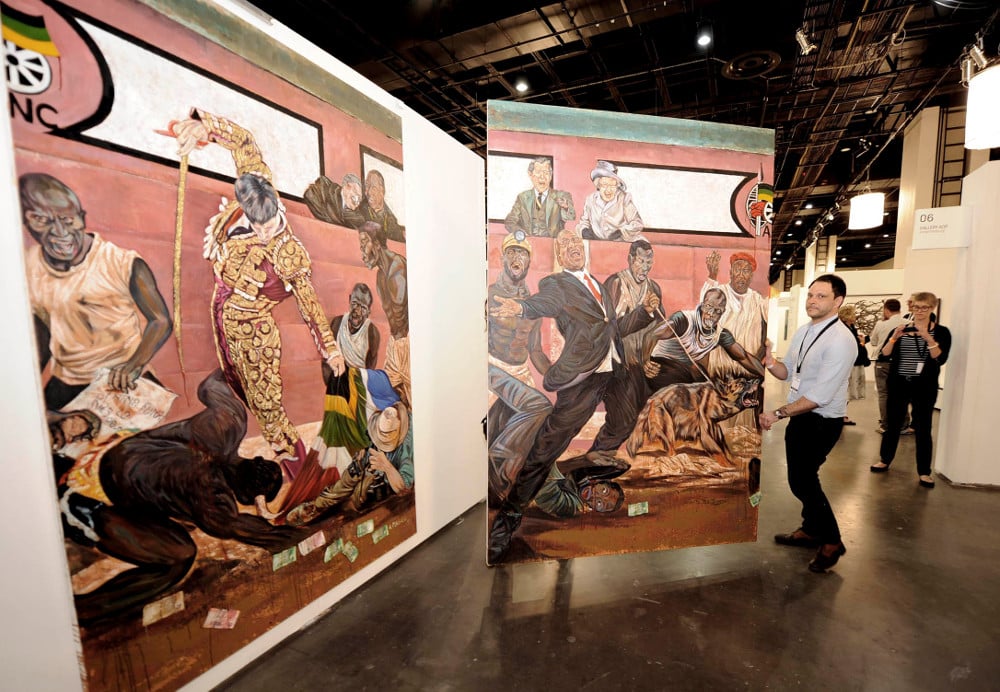Art Week, the FNB Joburg Art Fair, Arts Alive and the Joburg Fringe – all kick off within days of each other, but what effect do they have on the sustainability of the critical and commercial aspects of art?
Joseph Gaylard, the head of Swiss Arts Council liaison office Pro Helvetia’s Johannesburg office, said this week that the city had long been a fundamental nexus and generator of production in the contemporary art field. “What the Art Fair and now the Art Week have done is to strategically position the city as a continental and emergent global centre for consumption.”
Visual Arts Network of South Africa director Molemo Moiloa said the Art Week, which received funding from the Gauteng Tourism Authority and the department of sports, arts, culture and recreation, aimed to get gallery communities speaking to one another and to bring galleries together in a community where that does not usually occur. Moiloa said the intention was to attract new audiences and widen the destinations they visit.
Art Week, a partnership between the Contemporary Art Development Trust and Artlogic that runs from August 19 to 24, is described as a platform to promote and reinforce existing strengths of the Johannesburg art scene by shuttling attendants between five creative hubs and 40 venues. The hubs, in Soweto, Rosebank, Maboneng, Braamfontein and Newtown, each had a day dedicated to them.
Carien Els, who does communications for Artlogic, which also produces the Art Fair, said the concurrent running of these events created a “feedback loop” that benefited both well-known and lesser-known artists.
Focus on art
“It helps to create exposure for the arts that they otherwise wouldn’t have if we didn’t make a hype about it,” says Els. “Art is not often a focus in South African society: it’s usually politics. And yet art can be all those things: enlightening, educational, cultural.
“We’ve brought in a PR company from London that has been doing our international press and we’re bringing out a large contingent of international press. The smaller Art Week events will help to highlight the smaller artists because in the Art Fair it’s often the bigger artists represented by galleries that will get the focus.”

Ayanda Mabulu’s Yakhal’inkomo (Black Man’s Cry) provided one of the major talking points of last year’s Art Fair. The painting was removed before later being reinstalled. (Denzil Maregele, Gallo)
Goodman Gallery media liaison Matthew Krouse said institutions such as the Goethe-Institut have invested their own public funds but whether or not Art Week fell within the realm of arts activism, or whether that was important, was debatable.
“It is a focus on city spaces and making those sustainable,” Krouse said. “It’s about commercial spaces and giving the public free art. This could encourage newcomers into the gallery space and break down the notion of gallery elitism.” Krouse said Art Week presented more opportunities for artists. “Take a [performance art] band like The Brother Moves On: it allows them to get into spaces that they might not have gotten into before in the sense that they want to be an arts band.”
National Arts Council funding panel member Andile Magengelele doubted that the curatorial detail of these interlinking events could have a significant impact in dismantling “what [curator and academic] Thembinkosi Goniwe called ‘invincible presences’.”
‘Cultural margins’
“You still have cultural margins and art happening in certain spaces because of the Art Fair,” he said. “Bringing people to Soweto, is, in and of itself, good – but you bus people in … It’s a spectacle for that day but in the end none of the most important artists in terms of the history of art in the context of what Soweto means to the world are involved. In the end, you end up looking at art that doesn’t fit in within a curatorial integrity and not in spaces that have been neglected for a long time.”
Chief curator at the Soweto Museums Khwezi Gule said what was good for the market was not necessarily good for criticality.
“But artists who have galleries are always going to benefit. Even then, it depends on which gallery you’re in and how far up the list in that gallery you happen to be. The appearance of more commercial activity doesn’t necessarily mean more artists benefit.”
Gule said these events were happening against a backdrop of public institutions in Johannesburg under strain and a rise in public institutions operating in a private way. He said that the Keleketla Media Arts Project had to abandon the Drill Hall in downtown Johannesburg because the building was in so much debt, and the Johannesburg Art Gallery is crumbling.